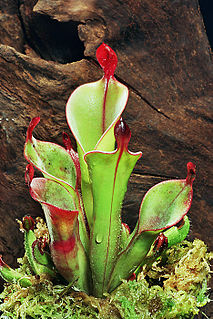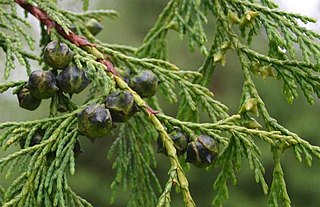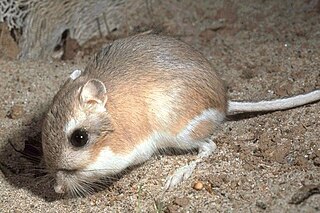Related Research Articles

Bacillus is a genus of Gram-positive, rod-shaped bacteria, a member of the phylum Firmicutes, with 266 named species. The term is also used to describe the shape (rod) of certain bacteria; and the plural Bacilli is the name of the class of bacteria to which this genus belongs. Bacillus species can be either obligate aerobes: oxygen dependent; or facultative anaerobes: having the ability to continue living in the absence of oxygen. Cultured Bacillus species test positive for the enzyme catalase if oxygen has been used or is present.

Binomial nomenclature, also called binominal nomenclature or binary nomenclature, is a formal system of naming species of living things by giving each a name composed of two parts, both of which use Latin grammatical forms, although they can be based on words from other languages. Such a name is called a binomial name, a binomen, binominal name or a scientific name; more informally it is also called a Latin name.

The genus Heliamphora contains 23 species of pitcher plants endemic to South America. The species are collectively known as sun pitchers, based on the mistaken notion that the heli of Heliamphora is from the Greek helios, meaning "sun". In fact, the name derives from helos, meaning marsh, so a more accurate translation of their scientific name would be marsh pitcher plants. Species in the genus Heliamphora are carnivorous plants that consist of a modified leaf form that is fused into a tubular shape. They have evolved mechanisms to attract, trap, and kill insects; and control the amount of water in the pitcher. At least one species produces its own proteolytic enzymes that allows it to digest its prey without the help of symbiotic bacteria.

Xanthocyparis vietnamensis, commonly known as the Vietnamese golden cypress, is a coniferous tree in the cypress family.

Xanthocyparis is a genus of cypresses in the family Cupressaceae, comprising one species native to North America and one native to Vietnam in southeast Asia.

Castorimorpha is the suborder of rodents containing the beavers and the kangaroo rats. A 2017 study using retroposon markers indicated that they are most closely related to the Anomaluromorpha and Myomorpha.

Gondwanatitan was a titanosaurian sauropod dinosaur. Gondwanatitan was found in Brazil, at the time part of the southern supercontinent Gondwana, in the late Cretaceous Period. Like some other sauropods, Gondwanatitan was tall and ate tough shoots and leaves off of the tops of trees. G. faustoi's closest relative was Aeolosaurus.

Lagosuchus is a genus of small avemetatarsalian archosaur from the Middle to Late Triassic period. It is generally thought to be closely related to dinosaurs, as a member of the Dinosauromorpha. Its fossils were found in the Chañares Formation of Argentina, the dating of which is uncertain; some sources date it to the Middle Triassic whilst others date it to the earliest Carnian.

Sarotherodon is a genus of oreochromine cichlids that are native to the northern half of Africa, with a single species, S. galilaeus, also ranging into the Levant. A couple of species from this genus have been introduced far outside their native range, and are important in aquaculture. Most other species have small ranges and some are seriously threatened. They mainly inhabit fresh and brackish water, but a few can live in salt water. Species in this genus, as well as those in several other oreochromine and tilapiine genera, share the common name "tilapia" and historically they were included in the genus Tilapia.

Altmuehlopterus is a genus of pterosaur belonging to the Pterodactyloidea. It lived in the Late Jurassic of what is now Germany. It was formerly known as "Daitingopterus", a nomen nudum, informally coined in 2004.
The Ethiopian big-eared bat or Ethiopian long-eared bat is a recently described species of long-eared bat in the family Vespertilionidae.

Corallimorpharia is an order of marine cnidarians closely related to stony or reef building corals (Scleractinia). They occur in both temperate and tropical climates, although they are mostly tropical. Temperate forms tend to be very robust, with wide and long columns, whereas tropical forms tend to have very short columns with a wide oral disc and very short tentacles. The tentacles are usually arranged in rows radiating from the mouth. Many species occur together in large groups, although there are recorded instances of individuals. In many respects, they resemble the stony corals, except for the absence of a stony skeleton. Morphological and molecular evidence suggests that they are very closely related to stony corals.

Undorosaurus is an extinct genus of ophthalmosaurid ichthyosaur known from western Russia.

Hudsonelpidia is an extinct genus of small parvipelvian ichthyosaur known from British Columbia of Canada.

Neptunidraco is an extinct genus of carnivorous marine crocodyliform which lived during the middle Jurassic period in what is now northeastern Italy. It is known from a partial skeleton recovered from the nodular limestone of the Rosso Ammonitico Veronese Formation. This specimen had been provisionally referred to an unnamed species of Late Jurassic Metriorhynchus or Geosaurus. Neptunidraco was named by Andrea Cau and Federico Fanti in 2011 and the type species is Neptunidraco ammoniticus. The "Portomaggiore crocodile" is the most complete specimen of an Italian metriorhynchid to date and the oldest known metriorhynchid.
Acolastodes is a monotypic snout moth genus in the subfamily Phycitinae. Its only species, Acolastodes oenotripta, is found in Fiji. Both the genus and the species were described by Edward Meyrick in 1934.

Sauroniops is a genus of carnivorous basal carcharodontosaurid theropod dinosaur known from the Late Cretaceous of Morocco.
Tataouinea is an extinct genus of sauropod dinosaur in the subfamily Rebbachisaurinae of Rebbachisauridae which lived in the Early Cretaceous Tunisia. Only one species, T. hannibalis, is known.

Amanita ananiceps is a species of agaric fungus in the family Amanitaceae native to Australia.
Plecotus gaisleri, also known as Gaisler's long-eared bat, is a species of bat in the genus Plecotus. It is medium-sized grayish-brown and found in Morocco, Algeria, Libya, and Tunisia.
References
- ↑ Nuss, Matthias; Landry, Bernard; Vegliante, Francesca; Tränkner, Andreas; Mally, Richard; Hayden, James; Segerer, Andreas; Li, Houhun; Schouten, Rob; Solis, M. Alma; Trofimova, Tatiana; De Prins, Jurate & Speidel, Wolfgang (2003–2011). "GlobIZ search". Global Information System on Pyraloidea. Retrieved September 29, 2011.
| This Phycitini-related article is a stub. You can help Wikipedia by expanding it. |